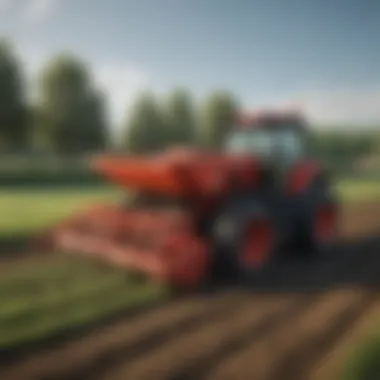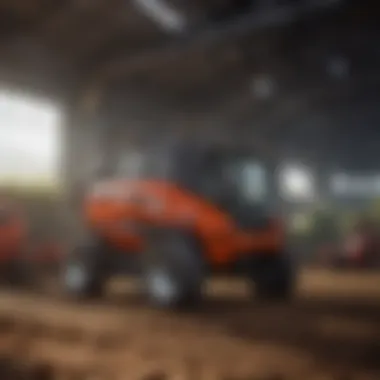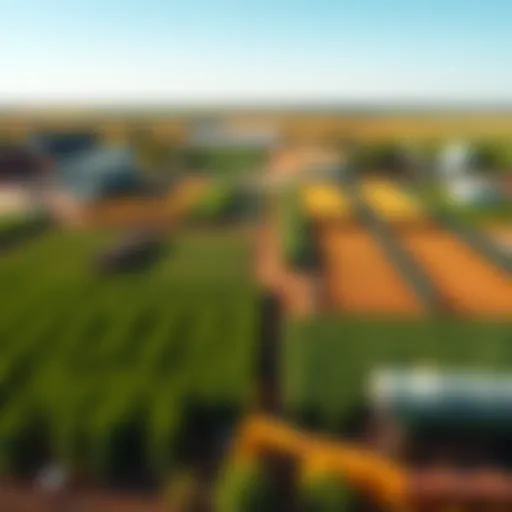The Comprehensive Guide to Cosmo Seed Spreaders


Intro
In modern agriculture, the efficiency of planting can significantly impact productivity and sustainability. One essential tool that has emerged in this domain is the Cosmo seed spreader. This device allows for precise distribution of seeds over a large area, maximizing coverage while minimizing waste. Understanding the design, functionality, and application of these spreaders is crucial for agricultural professionals and enthusiasts alike. This guide will explore fundamental concepts, recent innovations, and practical techniques related to Cosmo seed spreaders, providing a comprehensive resource for those involved in farming.
Key Concepts and Terminology
Basic Definitions
Cosmo seed spreaders are machines designed to evenly distribute seeds across a specified area. They can be operated manually or automatically, depending on the model. Seed spreaders reduce time and labor associated with planting, making them an invaluable asset on the farm. Key terms related to seed spreaders include:
- Seed Metering: The process of controlling the amount of seed released from the spreader.
- Spread Width: The width covered by the spreader while it operates.
- Calibration: Adjusting the spreader to ensure the correct amount of seed is distributed.
Historical Context
The use of seed spreaders dates back several centuries, but the modern iteration has developed significantly. Early models were basic, often hand-cranked devices that required significant labor and skill. Over time, advancements in technology allowed for the creation of more efficient machines that improve planting speed and accuracy. Cosmo has been a notable brand in this field, focusing on design and smart engineering to enhance user experience.
Recent Innovations and Trends
Technological Advancements
In recent years, Cosmo has integrated several innovations within their seed spreaders. For instance, many models now include:
- GPS Technology: This enables precise mapping of the sowing area, reducing overlap and gaps.
- Variable Rate Technology: Allows adjust the seed quantity based on specific field needs, optimizing resources.
- Automatic Calibration: Reduces manual effort by automatically adjusting settings for optimal performance.
Sustainable Practices
As sustainable agriculture becomes increasingly important, Cosmo seed spreaders have adapted to meet these needs. Using these machines can promote practices such as:
- Reduced Seed Waste: Accurate distribution minimizes excess seed that might otherwise go unused.
- Optimized Crop Yield: Ensures each plant has the best chance to thrive without overcrowding or under-seeding.
- Soil Health Maintenance: By promoting even growth, soil quality remains consistent, thus enhancing overall farm health.
Practical Applications and Techniques
Step-by-step Guides
To maximize effectiveness when using a Cosmo seed spreader, follow a structured approach:
- Prepare the Field: Clean the area to remove debris or obstacles.
- Select the Seed: Choose the appropriate seed based on soil type and climate.
- Calibrate the Spreader: Ensure the settings match seed type to guarantee accurate distribution.
- Test a Small Area: Run the spreader over a small plot to check dispersion.
- Adjust as Necessary: Fine-tune settings based on results from the test.
- Begin Full Operation: Proceed with planting across the field.
Case Studies
The successful adoption of Cosmo seed spreaders can be seen in various agricultural settings. For example, a farm in Ohio reported a reduction in planting time by 30% after incorporating a Cosmo seed spreader. This allowed them to allocate resources efficiently, leading to better crop yields over multiple seasons.
"The shift to using Cosmo seed spreaders has revolutionized our planting methods. We no longer fear patchy crops due to uneven sowing."
— Local Farmer
Understanding Cosmo seed spreaders provides a pathway to improved agricultural practices. Their design and functionalities are tailored to meet the evolving needs of today's farmers, ensuring productive and sustainable operations.
Prolusion to Cosmo Seed Spreaders
Cosmo seed spreaders are an essential tool in modern agriculture. Their importance lies in how they facilitate efficient sowing practices, essential for maximizing crop yield. Understanding the intricacies of these tools empowers farmers and enthusiasts alike to make informed decisions. This section unpack the fundamental concepts of cosmo seed spreaders, setting the stage for deeper exploration of their design, application, and benefits throughout the article.
Definition and Overview
A cosmo seed spreader is a device designed to distribute seeds evenly over a field. These tools are generally categorized based on their mechanism of seed distribution, which can include broadcast and drop spreading methodologies. Broadcast spreaders throw seeds over a large area, while drop spreaders release seeds directly onto the ground in a controlled manner. This precision in sowing helps ensure better germination and crop establishment.
Using a seed spreader minimizes manual labor and increases efficiency during the planting season. The growing reliance on technology in agriculture mandates that farmers adopt equipment that enhances productivity. Thus, understanding cosmo seed spreaders in this context is critical for anyone involved in farming or agricultural management.
Historical Context
The evolution of seed spreaders has roots in ancient practices of agriculture. Traditionally, sowing was conducted by hand, which was time-consuming and often imprecise. As agricultural needs grew, farmers sought better methods for seed dissemination.
In the 20th century, advancements in mechanization introduced innovative machinery like the cosmo seed spreader, allowing for greater efficiency. These devices gradually became a standard in various agricultural environments, from small family farms to large agribusiness operations. Today, as technology evolves further with the inclusion of smart features and automation, understanding the historical development of seed spreaders gives context to their significance in contemporary farming.
"Tools like cosmo seed spreaders not only simplify the process of planting but also contribute to more sustainable agricultural practices."
By reflecting on the historical context of cosmo seed spreaders, one can appreciate their impact on agricultural productivity. Knowing how far the technology has come sets a relevant foundation for grasping the subsequent sections of this guide.
Design and Features of Cosmo Seed Spreaders
When delving into the subject of Cosmo seed spreaders, understanding their design and features is essential. The design directly affects their functionality and efficiency in seed distribution. A well-designed spreader efficiently manages seed flow and ensures uniform coverage, which is crucial for achieving optimal crop yields.
Construction Materials
The choice of materials used in construction significantly influences the durability and performance of seed spreaders. Most Cosmo seed spreaders utilize high-quality metals, like steel, which provide strength and resilience. These materials resist wear from various environmental conditions, allowing for extended use without frequent replacements. Additionally, composite materials can also be employed in less critical components, offering lightweight properties that enhance maneuverability.
- Durability: Steel construction ensures long life and resistance to rust.
- Weight: Composite materials contribute to lighter designs, easing transport and operation.
- Maintenance: Durable materials often require less maintenance, thus saving time and effort for the farmer.
Types of Spreaders


Understanding the different types of Cosmo seed spreaders can help users select the most suitable option for their needs. Each type has unique features, benefits, and specific applications.
Broadcast Spreaders
Broadcast spreaders are a popular choice among farmers for their ability to cover large areas quickly. They scatter seeds in a wide pattern, allowing for rapid sowing across extensive fields. The key characteristic of broadcast spreaders is their ability to adjust the spread width, which is vital for different seed types.
- Advantages:
- Disadvantages:
- Speedily covers large areas, perfect for minimal time investment.
- Adjustable settings allow flexibility for diverse seed sizes.
- Possible uneven seed distribution if not adjusted properly.
- May not be suitable for small or delicate seeds, as they can be blown off target.
Drop Spreaders
On the other hand, drop spreaders offer precise seed placement by letting seeds drop directly onto the soil. This feature is particularly beneficial for users looking for accuracy in their sowing methods. Drop spreaders are effective for smaller areas or when uniformity is critical.
- Advantages:
- Disadvantages:
- Exact seed placement reduces waste and enhances germination rates.
- Ideal for small gardens or patches needing specific care.
- Slower than broadcast spreaders, which may not be suitable for large fields.
- Requires careful handling to ensure even spacing.
Tow-Behind Models
Tow-behind models are designed for those who require a blend of simplicity and efficiency in their operation. These seed spreaders attach to a lawn tractor or ATV, allowing for automated use. A notable feature of tow-behind models is their ability to handle heavier loads without compromising mobility.
- Advantages:
- Disadvantages:
- Increased mobility allows for quick transport between jobs.
- Heavy-duty capacity accommodates larger seed quantities.
- Requires a towing vehicle, which might not suit all users.
- Potentially higher upfront investment than simpler models.
In summary, selecting the right Cosmo seed spreader requires careful consideration of construction materials, as well as the types and their respective advantages and disadvantages. An understanding of these elements enhances the efficiency of seed spreading operations and ultimately contributes to better agricultural practices.
Mechanics of Seed Spreading
The mechanics of seed spreading is a critical component in the overall efficiency of agriculture. Understanding how seed spreaders function not only enhances one's ability to apply seeds effectively but also significantly contributes to crop yield and sustainability. This section delves into the details of how seed spreaders work and the importance of adjusting their settings according to the specific needs of the operation.
How Seed Spreaders Work
Seed spreaders operate on a straightforward principle: they distribute seeds evenly across a designated area. These devices utilize a combination of mechanical processes and gravitational forces to achieve uniformity and coverage. When a seed spreader is engaged, it releases seeds from a hopper through either a spinning disc or a drop mechanism, depending on the type of spreader in question.
Understanding the science behind this process is vital. It directly affects the rate of germination and plant development. Uneven seed distribution can lead to patchy crops and wasted resources. Moreover, familiarity with the mechanisms ensures proper calibration to various conditions such as wind, soil type, and seed size, maximizing effectiveness.
Adjusting Spreader Settings
Adjustments to spreader settings are crucial for optimal performance and efficiency. Incorrect settings can result in either seed wastage or ineffective sowing, leading to poor crop outcomes. Two important factors in these settings are seed size compatibility and the rate of application.
Seed Size Compatibility
Seed size compatibility ensures that the seeds can be adequately processed through the spreader without causing blockages or erratic distribution. Different spreaders come designed with varied mechanisms to handle a range of seed sizes. Choosing a spreader that is capable of accommodating the specific seeds is essential.
- Key Characteristics: Adjustments based on seed size contribute substantially to the overall effectiveness of sowing. Larger seeds may require wider opening and different disc rotation rates.
- Unique Features: Certain spreaders like the Cosmo PRB Series are explicitly designed to handle both small and large seeds effectively, allowing versatility in planting methods. This adaptability can minimize labor costs and enhance the efficiency of planting.
- Advantages: Correctly sizing seed for your spreader not only improves distribution but also ensures a higher rate of germination since all seeds are sown at the correct depth and spacing.
- Disadvantages: On the flip side, if one fails to adjust the spreader settings for the specific seed size, the operation can suffer, resulting in either clogging or over-sowing.
Rate of Application
The rate of application represents how many seeds are dispensed per unit area over time. This measurement is crucial as it determines the density of the crop in the field.
- Key Characteristics: Factors such as soil type and moisture content can affect the ideal application rate. A spreader with a flexible rate of application feature can greatly increase adaptability in changing environmental conditions.
- Unique Features: Models equipped with electronic controls can adjust the rate of application on the fly, providing direct feedback on performance. This technology is particularly beneficial for precision farming.
- Advantages: An accurate rate of application allows for controlled growth conditions, ensuring plants are not competing too heavily for nutrients or sunlight.
- Disadvantages: If application rates are too high, it can lead to overcrowding, while being too low may mean uneven germination and increased weeding processes later in the growth cycle.
Correctly adjusting the mechanics of seed spreaders plays an essential role in effective sowing practices and sustainable agriculture.
Application in Agriculture
The role of cosmo seed spreaders in agriculture is critical for efficient planting practices. These tools enhance the effectiveness of sowing by ensuring that seeds are distributed uniformly across the field. This article emphasizes the need for proper application techniques and how they can influence crop yield, soil health, and overall agricultural productivity. A well-planned application strategy allows farmers to maximize their resources while minimizing waste, improving the sustainability of farming practices.
Field Preparation
Field preparation is an essential step in the agricultural process. Before applying seeds, the ground must be adequately prepared. This means tilling the soil to create a suitable seedbed that promotes germination and growth. Properly prepared fields allow seeds to make good contact with the soil, which is vital for water absorption and nutrient uptake. Additionally, field preparation can help manage weeds and pests, reducing competition for resources and ensuring that the planted crops thrive.
Using a cosmo seed spreader during the sowing process allows for an even distribution of seeds, which is a large part of successful field preparation. When seeds are spread uniformly, crops grow more consistently, which can lead to higher yields.
Crop Types Best Suited for Broadcast Sowing
Broadcast sowing is suitable for various types of crops. Understanding which crops benefit the most from this method can help farmers make informed decisions.
Grasses


Grasses are a popular choice for broadcast sowing. Their key characteristic is rapid establishment, which allows them to cover the ground quickly. This can help with weed suppression and soil erosion control. Grasses can also improve soil structure and health over time. However, they require careful management to avoid competition among species, which can lead to uneven growth patterns.
Legumes
Legumes, such as clover and peas, are another beneficial crop for broadcast sowing. They are known for their ability to fix nitrogen in the soil, which enhances soil fertility. The ability to enrich the nutrient content makes them an excellent choice for rotation systems, benefiting subsequent crops. However, legumes may take longer to germinate compared to grasses, meaning that timing is crucial for successful growth.
Cover Crops
Cover crops play a vital role in sustainable farming practices. They are often sown to prevent soil erosion, improve soil health, and enhance biodiversity. Cover crops can be sown using a cosmo seed spreader effectively due to their varied seed size and weight. They contribute not just to soil fertility but also to pest control, making them a valuable part of an agricultural cycle. The downside is that managing cover crops requires additional planning, as they must be terminated at the right time to avoid competition with main crops.
"The strategic use of cover crops can lead to reduced chemical inputs and an overall healthier agricultural ecosystem."
Farmers and agricultural enthusiasts should consider the benefits and challenges associated with each type of crop during the planning process. Incorporating the correct crop selection with cosmo seed spreaders will add value to the agricultural practices, driving better outcomes in crop performance.
Benefits of Using Cosmo Seed Spreaders
The significance of utilizing Cosmo seed spreaders extends beyond mere convenience. These devices revolutionize the seeding process, leading to enhanced productivity and overall better outcomes in crop management. A thorough understanding of the advantages can significantly impact your farming strategy. Here, we delve into key benefits that Cosmo seed spreaders offer to agricultural practices, illuminating their role in modern farming.
Efficiency and Time-Saving
Cosmo seed spreaders are designed to save time through their operational efficiency. Using a seed spreader allows farmers to cover larger areas in shorter periods compared to manual sowing. This is particularly noticeable in fields where seeds must be distributed uniformly and quickly. For example, a broadcast spreader can scatter seeds over a wide area, ensuring that minimal time is wasted during planting.
Additionally, the mechanized operation reduces the physical strain on farmers. By minimizing manual labor, significant hours can be redirected toward other important farm activities, such as irrigation or pest control. This time-efficiency is especially vital during peak planting seasons when conditions can change rapidly.
Uniform Seed Distribution
Uniformity in seed distribution is crucial for maximizing crop yields. An even sowing ensures that each seed has equal access to soil nutrients, water, and sunlight, which encourages reactive growth. Cosmo seed spreaders, with their precise engineering, facilitate this uniformity.
When using a high-quality Cosmo seed spreader, the likelihood of overlapping or bare spots decreases considerably. This technology helps in achieving an optimal seeding density per area, leading to better crop establishment. Furthermore, uniform seed distribution can also reduce wastage and enhance resource efficiency, providing economic benefits in the long run.
"Using a seed spreader not only streamlines the planting process but also significantly boosts the potential for successful crop growth."
Reduced Labor Costs
Labor costs can greatly impact the profitability of agricultural operations. By adopting Cosmo seed spreaders, farmers can decrease their reliance on manual labor. Less manpower is required to oversee the seeding process, which translates into lower labor costs.
Furthermore, when more seeds are planted effectively and efficiently, it minimizes the need for replanting. If plants do not grow as expected due to poor seed coverage, additional labor will be needed to address these issues. Thus, the initial investment in a Cosmo seed spreader quickly pays off by promoting better seed performance and reducing extra expenses associated with labor and replanting efforts.
In summary, the advantages of using Cosmo seed spreaders are clear. They enhance efficiency, ensure uniform seed placement, and significantly lower labor costs. Farmers who recognize these benefits can better strategize their planting processes, leading to improved crop yields and overall farm sustainability. Attention to these elements contributes to a better understanding of how to optimize the use of seed spreaders in agricultural practices.
Choosing the Right Cosmo Seed Spreader
Selecting a cosmo seed spreader is a vital decision for anyone involved in agriculture or gardening. The right spreader can make a difference in seed distribution, which ultimately affects crop yields. There are several factors to consider when choosing one. These include the scale of your operation, the types of seeds you plan to sow, and how often you intend to use the spreader.
A good choice can enhance efficiency, save time, and lead to better seed germination rates. It is not merely about picking a machine; it is about aligning the tool with your specific needs. Misjudging the requirements can lead to significant inefficiencies, wasted resources, and increased labor. Thus, this stage of evaluation is critical.
Evaluating Your Needs
When looking for the right cosmo seed spreader, start by assessing your planting requirements. Think about the size of the area you will cover. If you have a small garden, a hand-held spreader may suffice. For larger fields, a tow-behind model could be more appropriate. Also, consider the types of seeds you will distribute. Some spreaders work better with specific seed sizes or shapes.
List your essential criteria, such as:
- Size of land: How many acres do you need to cover?
- Seed types: Will you use small grass seeds or larger legumes?
- Frequency of use: How often will you spread? Daily, weekly, or seasonally?
- Budget: How much are you willing to invest?
A thorough evaluation will guide your purchasing decision effectively.
Comparing Different Models
Once you understand your needs, the next step is to compare various models of cosmo seed spreaders. This can involve looking at features, pricing, and customer reviews. Each model serves its purpose, but knowing how they differ can lead you to the best choice.
Here are some essential aspects to compare:
- Capacity: Check how much seed each spreader can hold. Larger capacities may save time but could be harder to maneuver.
- Type of application: Evaluate whether a broadcast spreaader or drop spreader suits your needs best. Broadcast spreaders are generally faster, while drop spreaders offer more precision.
- Build quality: Look for durable materials that can withstand repeated use. Steel frames often have better longevity than plastic.
- Adjustability: Ensure the model has settings you can adjust for different seeds and application rates. This gives flexibility in use.
"Performing a detailed comparison helps to understand the strengths and weaknesses of each model."
Overall, the right choice of cosmo seed spreader can impact your agricultural output significantly. Take the time to evaluate your needs and compare the available options. The investment in a suitable machine pays off in the long run.
Maintenance of Cosmo Seed Spreaders
Maintaining cosmo seed spreaders is vital for optimal performance and longevity. Regular upkeep can significantly enhance the efficiency of seed distribution and ensure that the equipment operates smoothly. Proper maintenance includes both cleaning and inspection, which prevents issues that could lead to inconsistent seed application or equipment failure. Whether you are a professional in the agriculture industry or an enthusiastic gardener, understanding these maintenance strategies is crucial for successful seed spreading.
Regular Cleaning Practices
Keeping your seed spreader clean is the first step in maintenance. After each use, it is essential to remove any residual seeds and debris. This prevents clogging and ensures that future applications remain consistent.
Cleaning Steps:


- After operation, empty the spreader completely.
- Use a brush or compressed air to dislodge any stuck materials.
- Wash the spreader with water and mild soap. Avoid harsh chemicals that may corrode components.
- Dry all parts thoroughly to prevent rust.
- Check and clean the spreader’s wheels, as dirt accumulation can affect mobility.
This routine can greatly enhance the lifespan of the spreader and maintain its performance.
Inspection and Repair
Routine inspection of your seed spreader can help identify potential issues before they escalate. This proactive approach not only saves time but also reduces repair costs in the long run.
Key Areas to Inspect:
- Hoppers: Check for cracks or leaks where seeds could escape. Inspect hinges for wear and tear.
- Spreading Mechanism: Observe the rotary or drop mechanism for proper function. Any obstruction could lead to uneven seeding.
- Wheels and Tires: Ensure that the wheels are properly inflated and in good condition. Severe wear can affect movement and distribution accuracy.
If you discover any issues during your inspection, timely repair is crucial. Replace any worn or damaged parts promptly to maintain the effectiveness of your seed spreading operation. Addressing minor repairs can prevent more significant, costly problems later.
Regular maintenance is not just about keeping your equipment clean; it’s about ensuring efficiency and maximizing yield in your agricultural endeavors.
By combining these practices, farmers can optimize their cosmo seed spreaders. This will lead to a productive and effective sowing process, ultimately enhancing crop yield and sustainability.
Troubleshooting Common Issues
Troubleshooting common issues is a critical aspect of maintaining the efficiency and effectiveness of cosmo seed spreaders. Problems can arise during operation, and being able to identify and address these issues quickly can preserve the longevity of the equipment and ensure consistent seed distribution. Understanding the common challenges faced, like clogging or inconsistent seed flow, can lead to cultivation practices that uphold high standards and productivity. When farmers and agricultural enthusiasts can adeptly resolve these issues, it reduces downtime and improves overall results in seed planting.
Clogging Problems
Clogging is a frequent issue encountered with cosmo seed spreaders. Seeds or material can become lodged in the spreader's mechanics, hindering flow and preventing even distribution of seeds over the targeted area. Some causes can include:
- Moisture: Humidity can clump seeds together.
- Seed Size and Shape: Some seed types may fit poorly in the spreader's design.
- Mechanical Faults: Worn-out augers or belts can contribute to this problem.
To manage clogging, regular inspections of equipment before and after use are essential. It is advisable to keep the spreader clean and free from debris. Furthermore, adjusting the settings for the specific seed type being used can also help in reducing occurrences of clogging. If issues persist, consulting her with the manufacturer's guidelines can provide specific remedies suitable for the model in use.
Inconsistent Seed Distribution
Inconsistent seed distribution can lead to uneven crop growth, ultimately affecting yield. This challenge can arise from various faults associated with seed spreaders. The primary reasons include:
- Improper Calibration: Spreader settings not adjusted for the seed type can cause uneven flow.
- Wear and Tear: Parts that have degraded may cause erratic seed spreading.
- Operating Speed: Distributing seeds while moving too fast can affect how evenly they are spread.
To address these concerns, it is critical to regularly test the spreader’s calibration. Ensure that you are familiar with operating speeds that suit the type of seeds used. For further improvement, reviewing the spreader's manual for guidelines on maintenance and settings is recommended. The importance of maintaining equipment cannot be overstated; properly functioning spreaders contribute significantly to achieving optimal agricultural results.
"Consistency in seed distribution plays a vital role in crop success. Addressing common issues like clogging and uneven dispersal ensures that every planting cycle is efficient and productive."
By understanding and resolving these common issues, farmers and enthusiasts may sustain higher productivity and achieve greater results in their agricultural practices. Keeping a proactive approach to equipment care will invariably support crop health and yield.
Sustainable Practices in Seed Spreading
Sustainable practices in seed spreading are essential for modern agriculture. With growing concerns about climate change, soil health, and biodiversity, it is crucial to adopt methods that minimize environmental impact. Cosmo seed spreaders can play a significant role in promoting sustainability while ensuring efficient sowing. This section delves into what sustainable practices mean in the context of using seed spreaders and highlights key elements that farmers and agricultural enthusiasts should consider.
Minimizing Environmental Impact
Using Cosmo seed spreaders can help reduce the harmful effects typically associated with traditional sowing methods. For instance, by ensuring precise seed placement, farmers can avoid overapplication. This not only conserves seeds but also minimizes chemical runoff, which can degrade nearby waterways.
Here are a few practices to adopt for minimizing environmental impact:
- Calibration of Seed Spreaders: Regularly calibrating a seed spreader ensures that the correct amount of seed is used, reducing waste.
- Consideration of Weather Conditions: Avoid spreading seeds in windy or rainy conditions, as this can lead to uneven distribution and seed loss.
- Fertilizer Management: Coupling seed spreading with appropriate fertilizer management can prevent excess nutrients from entering the ecosystem.
- Cover Crops Implementation: Planting cover crops can enhance soil health and reduce erosion, facilitating better seed germination and crop yield.
"By integrating sustainable practices into seed spreading, farmers can contribute to a healthier ecosystem while maintaining productivity."
Implementing these practices will yield long-term benefits for the environment and the agricultural community, fostering a more resilient approach to farming.
Integrating Cover Crops
Integrating cover crops into the planting process is one of the most effective sustainable practices for seed spreading. Cover crops, such as clover and rye, are planted not for harvest but to improve soil health and prevent erosion. These crops play a vital role by enhancing soil structure, maintaining moisture, and providing habitat for beneficial organisms.
Some advantages of integrating cover crops are:
- Improved Soil Fertility: They naturally fix nitrogen in the soil, reducing the need for chemical fertilizers.
- Erosion Prevention: Root systems from cover crops hold soil in place, protecting it from wind and water erosion.
- Pest Management: Certain cover crops can disrupt pest life cycles, minimizing infestations during the main growing season.
- Biodiversity Boost: Planting a variety of cover crops can support a diverse ecosystem, promoting overall farm health.
End
The conclusion serves as the final synthesis of all the concepts discussed throughout the article. In this case, it wraps up the insights on cosmo seed spreaders, highlighting how these tools benefit modern agriculture by ensuring timely and accurate seed distribution. The importance of choosing the right model cannot be overstated, as it directly affects planting efficiency and crop success.
The Future of Seed Spreaders
As we look forward, the evolution of cosmo seed spreaders seems to incorporate advanced technologies. Automation and precision farming are areas of focus. Most new models are designed to work seamlessly with GPS systems. This integration allows for more precise seed placement, tailored to the specific needs of various crop types. Data analytics will likely play a larger role, helping farmers assess and optimize their spreading techniques.
Additionally, sustainability is becoming central in agricultural practices. Newer seed spreaders may focus on reducing overlap and waste, enhancing not only yield but also minimizing environmental impact. Farmers who adapt to these advancements can expect greater efficiencies in their operations.
Final Thoughts and Recommendations
In closing, it is essential for any farmer or agricultural enthusiast to understand the various aspects of cosmo seed spreaders. This includes evaluating one’s specific needs, comparing different models, and committing to regular maintenance.
A well-chosen seed spreader can save time, reduce labor costs, and ensure uniform seed distribution, ultimately leading to improved crop yields. When selecting a model, factors like size, type of spreader, and features should be considered carefully.
Investing in quality machinery today will pay dividends in the future, ensuring productive and sustainable practices.
For those looking to enhance their planting methods, keep an eye on emerging technologies and innovations in the market. Stay informed about advancements to select the best tools for effective seed spreading.















